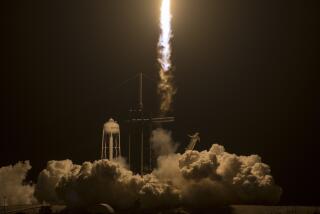NASA satellite plunges to Earth
- Share via
A defunct NASA satellite, whose doomed descent gained worldwide notoriety, fell back to Earth early Saturday — but exactly when or where the fiery plunge took place could forever be a mystery.
“We may never know,” said Nicholas Johnson, NASA’s chief orbital debris scientist.
It probably plunged into the Pacific Ocean, perhaps somewhere between Hawaii and the western coast of North America. There have been no reports of discovered pieces or injuries, further suggesting the debris didn’t make it to land, he said.
On its final orbit of Earth, the six-ton climate satellite flew over Canada, headed south over Africa, blew south of Australia and took a turn to the northeast over the Pacific Ocean heading toward Canada.
NASA officials believe the satellite then entered Earth’s atmosphere at about 12:16 a.m. Eastern time over the Pacific Ocean, far west from the U.S. West Coast, based on estimates from the Joint Space Operations Center at Vandenberg Air Force Base in California.
But because officials have yet to determine precisely when or where the satellite penetrated the earth’s atmosphere, they are unable to figure out where pieces of the school-bus-size satellite landed.
“Because we don’t know where the reentry actually was, we don’t know where the debris field might be,” Johnson said.
If their estimates are off, even by a few minutes, the fiery metal debris could have rained down somewhere in North America.
Though NASA received some reports from people who believed they spotted the satellite, none were during times it would have been visible to them. Others who were watching along the West Coast during the correct time frame didn’t see it, Johnson said.
“That would suggest that the reentry did in fact occur before it reached the North American coast,” Johnson said.
NASA predicted that the Upper Atmosphere Research Satellite, the largest to ever fall back to Earth in 32 years, would break into 26 pieces and fall over a 500-mile swath.
The agency is awaiting more information from the Joint Space Operations Center and from possible eyewitnesses on airliners and ships to make a closer approximation, Johnson said.
The satellite aroused sizable interest online, with many tracking its descent in the days leading up to the impact.
It had been expected to reenter the atmosphere Friday but not over North America. However, its descent slowed and it was expected to fall late Friday or early Saturday, increasing the threat of it falling into the United States.
NASA put the odds of a person getting hit by a piece of satellite debris at about 1 in 21 trillion.
More to Read
Sign up for Essential California
The most important California stories and recommendations in your inbox every morning.
You may occasionally receive promotional content from the Los Angeles Times.











